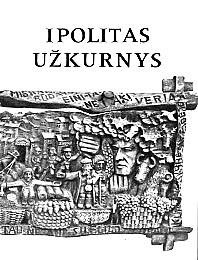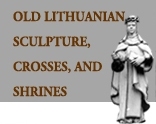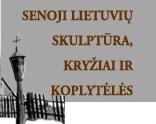IPOLITAS
UZKURNYS
Zita Zemaityte,
Marcelijus Martinaitis: Summary (Ipolitas Uzkurnys / Prepared by M.
Martinaitis, Z. Zemaityte. V.: Vaga, 1987. 174 p., iliustr.
- Ipolitas Uzkurnys, an artist of
inborn talent, rich fantasy, spontaneous temperament and fanatical
love for his calling, is one of the most prominent Lithuanian folk
sculptors. In addition, poems, short stories
 and
memoirs, written in lively vernacular, flow out of his pen with
the same ease with which he handles his chisel. and
memoirs, written in lively vernacular, flow out of his pen with
the same ease with which he handles his chisel.
Indeed, as the saying goes, "The muses do like company".
Ipolitas Uzkurnys was born on November 3, 1926, in the village of
Pypliai (now Ukmerge Rajonas), the son of a peasant. His artistic
inclinations surfaced in his early childhood but remained
supressed because of the straightened circumstances. As a young
man, I. Uzkurnys experienced the strains of hard physical lab our:
he ploughed the land, worked as a mason, builder, and joiner. His
eighteenth year found him in the trenches of World War II. After
the war I. Uzkurnys settled in Vilnius and worked at various
plants and in his own time he carved. In 1965, already in his late
thirties, I. Uzkurnys exhibited his sculptures for the first time.
And the success and appreciation were immediate. The singing,
smiling, and grieving world of his naive young girls, cowboys, and
ploughmen, bearing the marks of the artist's temperament and
energy, appealed to Lithuanian viewers.
- I. Uzkurnys carves sculptures, high
reliefs, bas-reliefs, and group compositions for interiors. In
addition, he is one of the most original Lithuanian folk
monumentalists. Carefully balanced fantasy and earthly facts are
characteristic of his works. The subjects of his monumental
sculptures are Lithuanian types, often with features of the artist
himself. The master's pictorial vocabulary is distinctly his own.
Discarding traditional proportions between the parts, he
concentrates on the expression of the dominant idea. Says the
artist, "I feel when it is time to work ... as if somebody
touches my heart, as if somebody whispers to me..."
Improvization is an important stage in his work. Starting to carve
a new sculpture he barely knows "what the result will
be". He submits to the urge of the medium - wood tells him
"how it should be". The artist would not bridle his
fantasy by sketches or plans: it is his imagination that prompts
him how to work. He meditates, "Any work of art is born only
once in the subconcious, and if you start at once the result will
be what you expected it to be. A sketch will lend artificiality. I
do not want to be repetitive".
- I. Uzkurnys has enriched Lithuanian
folk art with his original interpretations of historical themes.
His
group compositions, carved out of a solid piece of oak (among
others, Zaigiris and The Kidnapping of Birute),
unite legends and historical facts into an impressive saga. These
sculptures attest to the artist's ability to combine his numerous
personages into an integral whole, with all elements serving the
main idea. Such are also his high reliefs Maironis, The
Anyksciai Pine Forest, and others. Besides, the latter
compositions, which ring as ballads of people's woes and
aspirations or as suferer's dreams and longings lived through and
originally interpreted by the artist, impress the viewer with the
freshness of primordial sincerity. I. Uzkurnys' artistic dinamism
manifested itself in 1972 when he was carving three sculptures for
the memorial of Ablinga, a village burnt alive by the fascists.
- I. Uzkurnys has executed about 700
works, among them 80 monumental sculptures, which are scattered
throughout Lithuania - in memorials, parks, and cemeteries. In his
tomb monuments I. Uzkurnys has continued the tradition of 18- and
19th-century folk architecture, characterized by wayside shrines
(Lithuanian koplytstulpis) and roofed poles (stogastulpis).
Of great importance for the master is living nature whose
vitality is embodied in his many works. Flowers, oak leaves, naive
birds cover the surfaces of his sculptures or form garlands
entwining his monuments.
I. Uzkurnys' works were exhibited in our country and abroad: in
Hungary, Czechoslovakia, the People's Republic of Poland, the
German Democratic Republic, France, Italy, Belgium, Norway,
Canada, and elsewhere. After eight hours at the plant, I. Uzkurnys
works another eight in his studio. For him, his sculptures are his
vocation, his life's essence, meaning and purpose. Asked if he
would continue to carve in case nobody cares for his creations, he
answers, "Certainly, I shall". Widespread throughout
Lithuania, his sculptures have become part of national culture.
His words of time and creative work sound as his credo, "Time
is like an elusive bird - no one will get back a single day or be
rewarded for wasted hours. I do not know what time has in store
for me. But I do know that I shall always be guided by the noblest
of ideas in my work as an artist".
|

